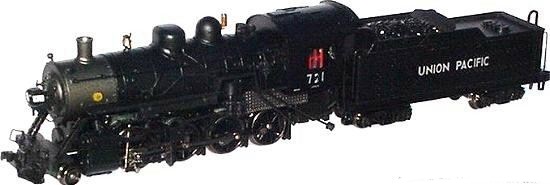

Introduced: 2001 (DCC-Ready Spectrum Version), 2010 (DCC-Equipped Spectrum Version) and 2018 (DCC-Sound Value Version)
This was Bachmann's first really great steam locomotive model - both in terms of looks and performance. Oh hell, who am I kidding? It was their first great locomotive model of any kind. And, peformance aside, it's all those factory-installed detail parts that really helped to make it something special (definitely raising the bar for N scale steam in general). OK, it can't quite match the nigh legendary Kato Mikado in terms of its performance, but it's definitely right up there. Not coincidentally, it was named Model Railroader's "N Scale Locomotive of the Year" for 2001. And do not confuse this model with Bachmann's earlier (1980s) "trainset-style" 2-8-0 Consolidation (reviewed elsewhere in this encyclopedia) - they have absolutely nothing in common.
There have been three distinctly different versions of this model - the first being simply "DCC Ready", the second sporting a factory-installed DCC decoder, and the third coming with a DCC-Sound decoder and speaker.
The so-called DCC "readiness" of the first version basically boils down to the fact that Bachmann provided space inside the engine for a decoder (along with providing wiring leads for track power, motor control and lighting all in the same general vicinity). So, no, not a "plug'n'play" installation by any means.

Ironically, Bachmann eschewed their own recommended decoder installation practices by placing the DCC-Equipped version's decoder inside the tender (said decoder replacing the original tender PC board, and with a wiring harness running between the tender and the engine). The tender, though similar in appearance to the one used on the first version, is actually one of Bachmann's newer "DCC-Ready" tenders (the one with the metal chassis). The only other difference between the two versions is the shell-mounted tender coupler - Rapido on the first version and Bachmann's McHenry-esque magnetic/automatic coupler on the second.
The tender PC board in this new version is actually two boards in one (functionally speaking). The forward half is the "main board" (to which the wiring harness plugs) and the rear half is the "DCC board". The DCC board is designed such that it can be snapped off from the main board (should you want to swap in a different decoder or run without a decoder entirely). Instructions included in the box show where to solder decoder wires to the main board (for running a different decoder) or what contacts to bridge on the main board if you want to run without a decoder.

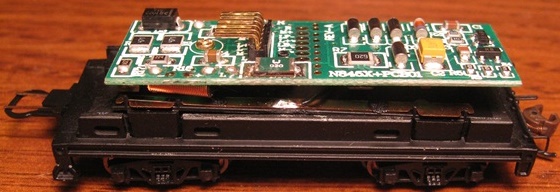
As for the shared features of the first two versions, the chassis is all-metal, split-frame and fairly hefty for its size. The motor is an open-sided / skew-wound 5-poler. Six of the eight drivers provide pickup (the third set of drivers from the front being equipped with traction tires). Additionally, pickup is provided by all eight tender wheels (with current being transferred between the locomotive and tender via a pair of stiff wires on the plastic drawbar). Driver current flows from the axles and on into the frame halves via brass bearing blocks that seat inside cutouts in the frame. Tender pickup is low-friction (needlepoint axles and dimpled axle wipers). Vertical extensions off the tops of the tender axle-wipers transfer current to contact strips inside the tender.
Only the center pair of driversets are geared (the other two driversets being turned solely by the running gear). All gearing is plastic. A PC board with a directional headlight is mounted in the front of the locomotive chassis (there is no backup light). The wheel flanges are low-profile, so no problems on Code-55 track. The pilot coupler is a dummy (non-operational) knuckle. A Rapido-style replacement for the pilot coupler is included with the first version (should you want to go that route). For whatever reason, said replacement was not included with the second version.
Uncoupling the tender from the engine is blessedly simple. Simply twist the tender 90 degrees and the drawbar pops right off. However, on the DCC-Equipped versions, you still have the wiring harness to deal with (IE, you have to pop the tender shell and unplug the harness before the locomotive and tender can be completely separated).
These models perform exceptionally well. Pickup is great (no stalls or stuttering through turnouts). Overall throttle response is smooth and fine, and slow speed creep is excellent. They do run a little louder than Kato's Mikado, but much quieter than, say, Model Power's Pacific. Basically, they're adequately quiet without being jaw-droppingly so. Pulling power is quite impressive for such a small locomotive, and I haven't had any problems with keeping all of the wheels on the rails.
On the downside, converting the tender coupler on the first version to a Micro-Trains coupler is not as simple as it could be. First, you have to remove the coupler box from the tender. Then you have to drill a hole in order to screw in a MT-2004 coupler assembly.
One caveat - the mechanism (as delivered from the factory) can be a bit "tight". And chances are, it may take a couple of small (simple) adjustments before your 2-8-0 will run properly. When I first got mine it was very herky-jerky at slow speeds. So, I tried out the suggestion from the Model Railroader review below and experimented around with loosening the three screws that hold the bottom cover plate in place. It seems that if the rear-most one (the one that holds the motor in place) is screwed in too tightly, it will cause the entire mechanism to bind. Loosening it a turn or so really frees things up.
Another caveat - like the rest of Bachmann's newer steamers, one does occasionally run into QC problems with the way the frames were manufactured. (specifically, flaws in the cut-outs in the frame where the driver bearing blocks seat). If not cast/milled properly, the cut-outs can wind up incorrectly sized/shaped, thus allowing the bearing blocks too much free play. And the end result is drivers that are wobbling all over the place (and in some cases actually coming off the rails, thus greatly reducing pulling power). If you wind up with a 2-8-0 so inflicted (and returning it to Bachmann isn't an option), one solution is to pull the #3 drivers and apply a bit of electrical tape to the bottom and sides of the frame cut-outs. This will work as a shim and force the drivers lower, thus eliminating the side-to-side wobbling, and (hopefully) keep the traction tires on the rails.
Yet another caveat - it seems that most (if not all) of the 2010 (decoder-equipped) 2-8-0's were delivered from China without a large and rather obvious detail part - namely, the "power reverse" on the right (engineer side). Vis -
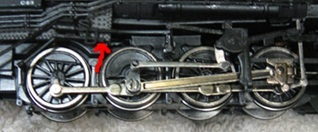
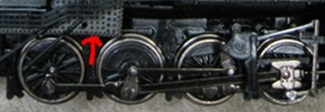
As of this 2013 writing, Bachmann is supplying replacement power reverses for free (provided you can send them a sales receipt). Failing that, they will sell you one for $1 (plus $5 for shipping).
For the third release (the DCC-Sound version), Bachmann did not simply take their existing 2-8-0 and add a decoder and speaker. Rather, it has a completely new chassis and motor -

According to the included parts diagram, the motor (#10228) is a small, round can (and presumably coreless). The rest of the parts (gears, drivers, etc) appear to be the same as on the previous two versions (as is the basic design of the mechanism). The locomotive and tender shells (and their part numbers) appear to be unchanged as well (and should, in theory, be swappable with earlier versions). Oddly enough, the ala carte Rapido-style replacement for the pilot coupler is once again included in the box.
The guts of the tender are quite different as well - featuring a new PC board to which is connected an Econami Soundtraxx decoder. The plug/harness connection between the tender PC board and the locomotive is also very different -

The tender chassis was revised to include speaker holes. And like the second version, some of the under-chassis details are separate press-fit plastic parts (said details were cast into the tender chassis itself on the first version; a fact that I never noticed until just now) -
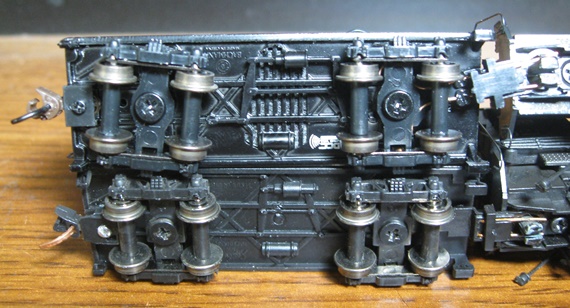
Overall performance on this latest version is very similar to the previous versions (IE excellent). Despite the wheel-blackening, mine ran smoothly right out of the box (and continued to do so during 10 hours of forward and backward roundy-rounding) . Pickup is flawless, slow speed creep is decent and the top-end speed is reasonable and realistic. The sound feature is quite respectable (certainly better than MRC's line of DCC-Sound steamers), but since I'm just not that big into DCC-Sound anymore my opinions in that regard are rarely glowing. Let's just put it this way - I think most people will be quite pleased with the sound.
On the downside, pulling power seems to have taken a bit of a hit with this release. Whereas my older 2-8-0's can handle around 25 assorted 50' freight cars through curves on level track, this newer one is spinning its wheels with any more than about 21 such cars. Weights seem to be about the same between the various releases, so I'm not sure what the deal is there. One other nitpick is that mine does exhibit a little bit of binding at speed step 1 (where it's just crawling along). Fortunately, it's barely noticeable and not anything that I felt compelled to address. Some lubrication and break-in time will likely smooth it out, and even if it doesn't it's just not that big of a deal.
So, although the slightly diminished pulling power is a bit of a disappointment, I'd still rate these DCC-Sound models as an overall "A" (just give the older ones an A+ for pulling power and the newer ones an A-).
Note that the "as delivered" CV settings on the DCC-Sound models are not the same as the "factory reset" settings. So, if you ever need to perform a factory reset, be sure to set CV211 back to 0 afterwards (otherwise BEMF will be messed up and slow speed control will go to hell). The factory default for CV211 is 180 and not 0.
Here's what Bachmann has to say about the DCC-Sound version -
Bachmann is delighted to offer this N scale Consolidation equipped with an Econami SoundTraxx steam package. Factory-set for 2-8-0 realism, the steam package offers a choice of 16 whistles, multiple variations of 6 bell types, 4 prototypical chuffs, 5 airpumps, and 4 dynamos plus cylinder cocks, grade crossing signal, blowdown, brake squeal/release, coupling/uncoupling, water stop, and "All aboard"/coach doors - all in 16-bit polyphonic sound.
Features -
- DCC sound-equipped with Econami decoder
- Precision motor
- Operating headlight
- Completely hidden drive train
- Separate sanding lines
- Separate detail parts, including bell, whistle, pop valves, and handrails
- Builder's plate
- E-Z Mate Mark II coupler, rear; dummy coupler, front
Note - Bachmann also lists "detailed cab interior" and "die-cast, fine-scale driver spokes" in the features, however mine is not so equipped. I think these were probably just copy/paste errors from the HO version's feature list.
Shell Removal -
To remove the locomotive shell, first free the forward ladders from the boiler. Next, free the handgrabs from the back side of the cab. Next, free the power reverse detail from the side of the shell. Lastly, pry the sides of the shell apart back by the cab. The whole thing should lift right off at that point (just give it a bit of a forward push at the same time to clear the headlight PC board).
The tender on the first version is a bit of an odd duck. It has a one piece casting that makes up the chassis and the sides, and then a top piece that slides inside of it. So, to get at the insides you would need to slide the top piece up and out -

The second (and later) version tenders are more traditional (separate chassis and body shell pieces). To remove the body shell, just stick a small screwdriver into the opening where the wires go in and pry upwards. This should free the shell clips from the chassis and raise it up and off.
Grade: A (for all versions)
First Version Review: 04/02 Model Railroader ("Bachmann's eagerly awaited N scale 2-8-0 has pulled up on the ready track and is just what we'd hoped it would be: a good-running engine with a wealth of detail rivaling high-ticket brass imports. Made in China, the locomotive is marketed in Bachmann's Spectrum line of higher-end products... It matches no prototype exactly but its quite close to the dimensions of an Illinois Central 900-series engine (1910)... This model is soundly engineered and, despite the abundance of parts, is easy to disassemble. Turn the tender 90 degrees sideways to the engine and it separates easily. Detach the rear cab handrails at the bottom. Shove the rear of the shell up and forward, and once its started, pry the cab pilot ladders free of the smokebox. The heart of the design is the metal frame that's split vertically into electrically isolated halves, as most quality N scale diesels are today... The frame holds the gears and drives in alignment and provides a mount for the small five-pole, skewed armature, open-frame motor. The motor plugs into the frame and is secured by a screw... On the motor's drive shaft is a brass worm that engages a pair of plastic spur gears, one above the other, transferring the power down to gears on the axles of the middle pair of drivers. Power to the remaining drivers is via the siderods. This strikes me as a better system than gearing all the axles... making potential siderod bind less likely. The main drivers have plastic traction tires...
"My engine ran well with just a hint of a bind at the slowest speed, and actually ran better after I'd taken it apart and put it back together... I've seen reports that some of these engines did not run well. One simple trick is to loosen the screws on the bottom cover plate a smidge. The engine should pull 21 cars... The driver axles are mounted in bronze bearings that float in slots in the frame, a very nice feature that helps the mechanism keep itself aligned. The locomotive picks up current via all drivers and all the tender wheels. Springy wires to each side of the drawbar rub the split kingpost sides to conduct current from the tender. Bachmann has given some thought to decoder installation and the motor is isolated from the frame. If you take out the weight behind the headlight, there's room for a decoder. The gray and orange motor leads would go to the decoder... The decoder's red and black wires would go to the posts the motor wires are presently connected to... The model comes equipped with a Rapido-style coupler on the tender... The front coupler is a dummy... Squeeze the tabs together behind the pilot to remove the stock coupler. The is the most highly detailed plastic N scale locomotive ever made and is inherently delicate... This is a well-engineered, good-running locomotive that takes N scale steam to new heights of detailing. UP, AT&SF, B&O, B&M, CRI&P, Clinchfield, NYC, NKP, SRR, WM, WP, Undec $135")